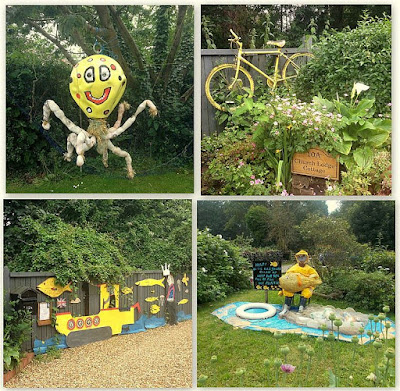Hale - little Giant Village
During her visit, Queen Elisabeth II described Hale as 'an oasis of green in an industrial landscape'. There is more to Hale Village, however. There are dozens of picturesque thatched, lime-washed cottages dating back to late 17th and 18th century, and other listed buildings. And there is a real giant...
Hale Village is at the southern corner of Liverpool, east of Speke but administratively it belongs to Cheshire, not Merseyside. The lighthouse, now private residency, on the shore of River Mersey used to be the most southern post of Lancashire. A former editor of Vogue magazine in the years 1940-1960, was born here.
There is a small shopping area, not very attractive, certainly useful for local residents. Passing a former chapel converted to a house on the corner of Pepper Street, further down Town Lane meeting High Street, we approached what probably used to be the proper village centre. Only old Post Office is left. At the centre of this Village Green is a World Wars memorial, accompanied by a cannon, Hale Village information board and some other sculptural bits and bobs. The local pub is called Childe of Hale, commemorating a local giant, literally.
This is another unique feature of this remote and tiny settlement - not a legend - a story based on facts, about Childe of Hale. His name was John Middleton, he was born in 1578 and died in 1623 and he was nine feet, three inches tall, 280 cm, a giant. Such his repute has been that his cottage and grave are still preserved in the village. A stroke of legend is that he slept with his feet out of a window in his small house (photo below, upper left). To examine and confirm his size his grave was dug up in the early 19th century.
Going down the Church Road, there is a statue of Childe John, three metres high, so a bit taller then he was, looking towards the cottage where he lived. Further down, at the St Mary Church graveyard is his tomb with an information board. He stirred quite an interest, hired as a bodyguard to the sheriff of Lancashire and visited King James I court.
The Manor House, from mid 17th century, was originally built as a vicarage. The central bay with Corinthian columns on each side of the entrance and above is a pediment with the arms of Rev Langford.
St Mary's Church tower dates from the 14th century, the rest of the church had been built in the mid 18th century. There is a floor-stone inside the church marking the burial of the Sherrif of Lancashire, Sir Gilbert Ireland, who hired John Middleton as his bodyguard. An old cemetery is behind the church.
This lovely little village keeps up with traditions and upon our visit, in the late summer, we could admire some of the villagers' quirky harvest-time garden exhibits.





